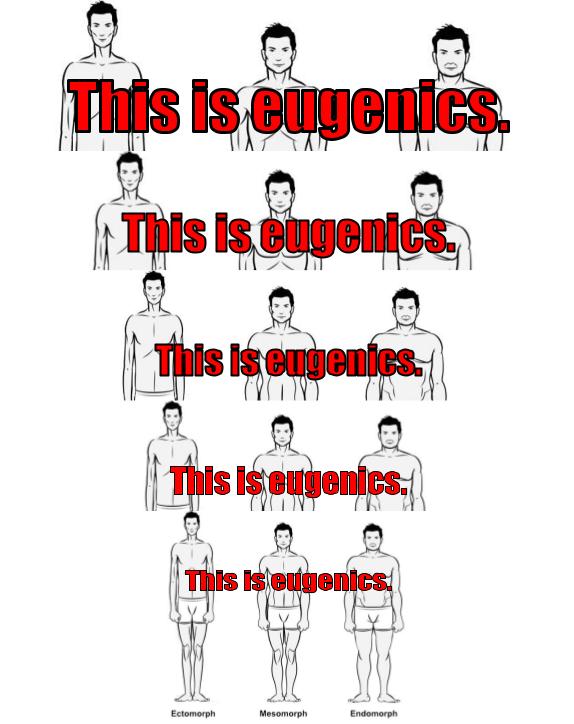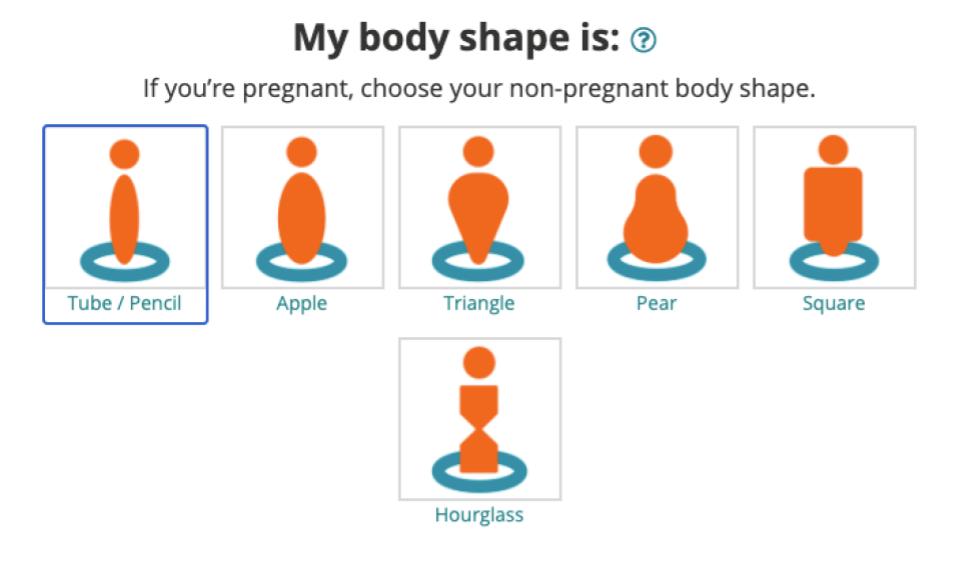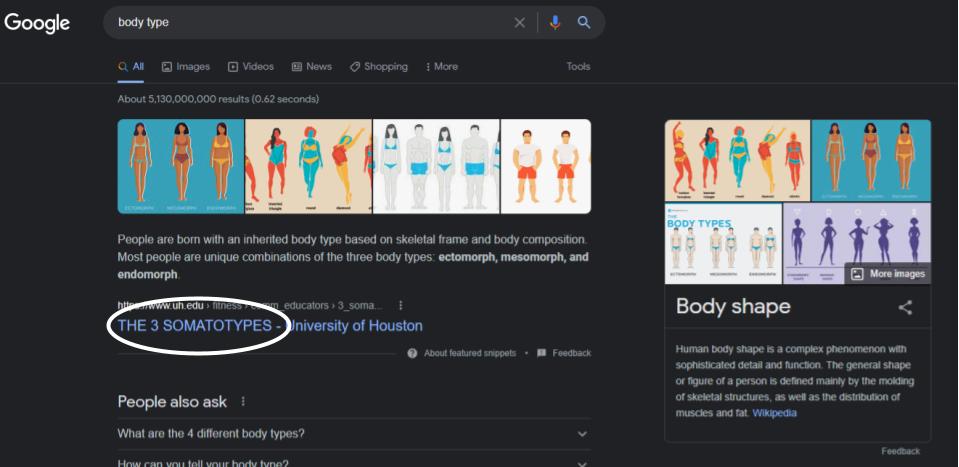
CW: Eugenics, racism, antisemitism, fatphobia, ableism
Note: As I was writing this post, I wanted to cite sources to show you that I’m not making stuff up about how bad somatotyping is. This means that links could lead you to racist, antisemitic, fatphobic, ableist content. I’ve put asterisks (**) by links that you should click on with caution. Use your best judgment and take care of yourself first! Also, this post involved a lot of research in library databases, so many links will take you to materials behind paywalls. If you have questions about any of the documents I used in my research, please let me know.
A friend (and friend of the blog) kindly agreed to share a screenshot from their workplace wellness “Personal Health Assessment.” My friend gave me permission to share some of his comments on the image, and the following paragraph struck me as particularly incisive:
Ah, the ever-bizarre, creepy, trying-too-hard-and-unsuccessfully-to-be-friendly-and-helpful workplace wellness Personal Health Assessment. In addition to chuckling very darkly while responding to the questions about depression and burnout, I had a moment of complete bewilderment with this new and exciting question — while named shapes are pervasive in discussion of women’s bodies, they’re largely absent when discussing men’s bodies.
This comment does such a good job of pointing out what is wrong with the image and with being asked to evaluate yourself mentally and physically during these Plague Times that I thought, “Great! I can do a quick visual defacement post and get on with my life.”

But then I did two Googles and you know what I found? EUGENICS.
EUGENICS EUGENICS EUGENICS.
Yes, I am still screaming inside my heart (and out loud) about this.
Am I surprised? No. If you’re talking about anything related to medicine/health, when you dig into the history you’ll usually find eugenics. Am I disappointed? Yes. A small, not-yet-shrivelled part of my soul hopes that people creating health-focused content have learned from the past and can manage to do two internet searches to find out if what they’re sharing or promoting is 1) based on accurate, not-discriminatory research, and 2) NOT EUGENICS.
A new, terrible game called “Two Googles to Eugenics”
Search 1: Body type

Search 2: Somatotype

Result: EUGENICS

So, if Wikipedia points out that it’s eugenics in paragraph two, why aren’t our workplace wellness programs paying attention?
Unfortunately, I can’t answer that question, but I can tell you how we got from eugenics to a game of Pick Your Shape as part of a personal health assessment. Join me on a brief and terrible journey through the history of scientific racism, eugenics, and somatotyping!
From scientific racism to “Are you an apple or a pear?”
Scientific racism, or “white people justifying their terrible behavior by saying it’s backed by data,” has been around since the Enlightenment (the National Museum of African American History and Culture has a useful historical overview of race as a concept and how science has been done in support of racism). It really took off, though, in the 1800s and early 1900s, when phrenology**, physiognomy**, and eugenics** gained both popularity and scientific credibility (credibility on the level of “we measured something and so it must be true”). People were subjected to measurement, experimentation, and—for people like Sara Baartman**—overt dehumanization and display. Basically, Europeans and Euroamericans were enslaving and colonizing people—and, especially in the US, doing that while also trying to keep people out—and needed justification for doing truly evil stuff, and scientific racism helped fill that need. (To be clear, scientific racism still** exists** today**.)
Somatotyping exists in a weird little corner of scientific racism and eugenics that started with Ernst Kretschmer and his creation of a 4-type classification system for body types in his 1921 work Physique and Character**. Kretschmer tied body types to different mental illnesses, which is already bad and dangerous. But it was William H. Sheldon who, like a true American innovator, took somatotyping to a new level by combining naked pictures and measurements of Ivy League undergraduates; racist, antisemitic, ableist, and fatphobic beliefs; and deeply questionable methodology to write three volumes in the 1940s: The Varieties of Human Physique (1940), The Varieties of Temperament** (1942), and Varieties of Delinquent Youth (1949).
He called his theory “constitutional psychology,” a theory which basically boils down to the belief that biology and body type determine personality and that we need to be careful about who we let reproduce. He divided people into three basic body types: ectomorph (tall and skinny), mesomorph (medium build and muscular), and endomorph (fat). His second volume, The Varieties of Temperament, built on this classification system and tied body types to basic personality (it’s also the only volume I had digital access to). The final section, “Some Theoretical Considerations,” includes Sheldon’s thoughts about the application of constitutional psychology. He writes:
If constitutional studies can lead to the establishment of a rational foundation for a science of heredity and eugenics, we may then hope, for example, to eliminate the principal constitutional and degenerative physical scourges of the race…But of greater importance than that, it might then also be possible by discriminate breeding to strengthen the mental and spiritual fiber of the race. (page 487)
OK, bro.
The word “eugenics” is right there. Sheldon isn’t hiding his agenda. And yet the reviews of his work by contemporaries that I read as I worked on this post did not point out that Sheldon was interested in promoting “discriminate breeding” and EUGENICS, instead quibbling (if they quibbled at all) with his methodology. Which, to be fair, his methodology was terrible, but EUGENICS IS WORSE.
I only found one contemporary book review (by S.L. Washburn) that critiques Sheldon’s assumptions, methods, and conclusions in the way they deserve, and I highly recommend reading it if you can stomach Washburn quoting—at length—some horrifying passages about Black and Jewish people. In his review of Sheldon’s third volume, Varieties of Delinquent Youth, Washburn notes that Sheldon and his coauthor are “clearly repulsed by most of mankind” and points out that the book has a “racist message.” He also argues that “The vast majority of data in this book are completely unacceptable by the authors’ own standards ” (emphasis is the author’s). The review uses italics so liberally that I can easily imagine Washburn having to take breaks to scream into the void while working on this review.
So, if someone like good old S.L. knew back then that Sheldon’s work was deeply problematic (and you know, that Sheldon’s work was OVERTLY RACIST AND PROMOTED EUGENICS), how is somatotyping still a thing?
I encountered Sheldon’s endo/meso/ectomorph classification system in high school health class, and a very unscientific poll of friends and family showed that about half of them had encountered these terms as well. Sites like this one** also promise to help you calculate your body type so that you can get absolutely shredded (this website is terrible and does a lot of fat-shaming in its choice of images).
“But Erika!” you might be saying, “Ectomorph, endomorph, and mesomorph appear nowhere in that image your friend sent you!” You, dear reader, are correct. So why am I screaming at you about Sheldon? Because his terms were replaced in a lot of US culture with fun metaphors! And metaphors mean it’s not eugenics anymore, right? (Wrong.)
A paper from the Journal of Textile and Apparel, Technology and Management draws a straight line from Sheldon’s work to contemporary body shape/type descriptions. Barbara Honeyman Heath, who had worked with Sheldon for years, came up with a revised system of somatotyping in collaboration with Lindsay Carter and continued publishing about it into the 1990s. Their work, along with work by Helen Douty, moved somatotyping into the realm of fashion and sports.
I don’t know who first proposed we use fruit metaphors to describe people’s bodies, but you’ll see somatotyping in fashion**, fitness**, and even medicine**. The paper from the Journal of Textile and Apparel mentions the confusing mix of terms coming from categories like “shapes, letters/numbers, and fruits/vegetables.” Alas, it does not tell us who decided that a mishmash of descriptors would somehow make judgments on people’s health and attractiveness more palatable, but I don’t think the who matters as much as what gets done with somatotyping.
How does somatotyping affect your morning commute?
Am I saying that the image my friend sent me is promoting eugenics? Maybe. It all depends on how it’s used.
If someone chooses “apple” as their shape and they’re told that they’re at higher risk for poor health outcomes**, then that’s harmful. If employers push people to certain programming based on their body shape, they’re deciding what an individual’s health needs are for them, which is paternalistic and gross. If an employer fires someone for being fat or an apple (the body shape that is most feared of all the shapes—tremble before it!), that’s even worse. (By the way: in the US, it’s legal to fire someone for their size everywhere but in Michigan and 6 cities.)
My hope is that this Choose Your Own Shape Adventure doesn’t impact employees’ Personal Health Assessments or their employment. I hope it’s just a waste of time. But even if it isn’t used for anything bad, this kind of somatotyping is still not a good thing to do.
First, you can’t tell someone’s health status just by looking at them. Body shape reveals almost nothing useful (unless you have a third arm growing out of your chest, then it’s quite useful for knowing Something has gone Terribly Awry). Second, getting people to scrutinize their bodies to figure out what shape they are encourages a level of self-surveillance that could be harmful, especially for employees with a history of body dysmorphia or even just regular old American Culture Wants Me to Hate My Body-itis. It’s just…not a good idea to do this under any circumstances because it provides no real benefit while causing or adding to real harm.
So, what can you do about it if you notice somatotyping in your workplace wellness program? Here are some suggestions:
- Talk to your coworkers about the history of somatotyping and how it was created by a eugenicist to further racist goals.
- Let the people in charge of your workplace wellness program know about the racist history of somatotyping.
- Get a group together and refuse to participate, and let the people in charge know why.
- If no one in charge responds to your concerns, get everyone to choose “tube/pencil” when asked their body shape. Because really, at the end of the day, aren’t we all tubes of skin filled with bones and organs and various types of goo? Wouldn’t a square person have sharp edges and defined corners? What about Asian pears? They’re a member of the pear family but are shaped like apples! What about them?!
I’ll stay vigilant for further examples of how eugenics creeps into workplace wellness, and good luck to you as you continue to wade through the muck.
(Header image adaopted from Granito diaz, CC BY-SA 4.0, via Wikimedia Commons)




